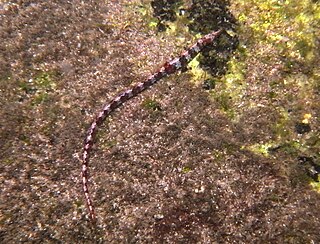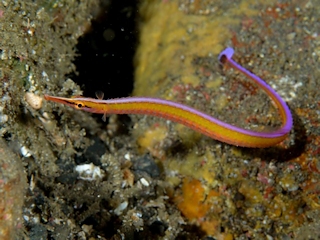Hypselognathus horridus, known commonly as the prickly pipefish or shaggy pipefish is a species of marine fish belonging to the family Sygnathidae This species lives on the continental shelf in depths ranging from 40 to 55 m. It is endemic to the Great Australian Bight, located in South Australia. Reproduction occurs through ovoviviparity in which the males brood eggs and give birth to live young
Microphis insularis, also known as the Andaman pipefish, is a species of freshwater pipefish belonging to the family Sygnathidae. This species is found only in rivers and streams located in the Andaman Islands, India. They can reach 16 cm (6.3 in) in length and reproduce through ovoviviparity, in which males carry eggs and give live birth. The Andaman pipefish is considered threatened likely due to the effects of habitat degradation, invasive species, and the alteration of flow of its freshwater habitats.
Hypselognathus rostratus, also known as the knife-snouted pipefish is a species of marine fish belonging to the family Syngnathidae. This species can be found in very shallow coastal waters of southeastern Australia. Their habitat consists of sandy substrates, seagrass beds, and estuaries. Reproduction occurs through ovoviviparity in which the males brood eggs before giving live birth.
Lissocampus fatiloquus, also known as prophet's pipefish is a species of marine fish belonging to the family Syngnathidae. The species has been noted in a variety of habitats including sargassum, seagrass beds and sandy substrates along the coast of Western Australia from Shark Bay to Rottnest Island. Their diet is thought to consist of small crustaceans such as copepods. Reproduction occurs through ovoviviparity in which the males brood eggs before giving live birth.

Lissocampus runa, also known as the javelin pipefish is a species of marine fish belonging to the family Syngnathidae. This species can be found in algae beds, rocky reefs, tidepools, and estuaries along the coast of southern Australia from Broken Head Nature Reserve in New South Wales to Rottnest Island, Western Australia. Their diet is thought to consist of small crustaceans such as copepods. Reproduction occurs through ovoviviparity in which the males brood eggs before giving live birth.
Maroubra perserrata, also known as the sawtooth pipefish is a species of marine fish belonging to the family Syngnathidae. This species can be found at depths up to 20 meters along the coast of Australia from southern Queensland to southern Western Australia. While they can live in many different habitats, they are often found inhabiting openings in reefs and rocks that contain algae and invertebrates, which they likely rely on for camouflage. Reproduction occurs through ovoviviparity in which the males brood eggs for roughly 22 days before giving live birth. Maroubra perserrata is considered more mobile than many pipefish species due to its prehensile tail and reduced caudal fin.
Penetopteryx taeniocephalus, also known as the oceanic pipefish is a species of marine fish belonging to the family Syngnathidae. The species can be found inhabiting coral rubble and gravel in many areas of the Indo-Pacific including Madagascar, Mauritius, the Philippines, Indonesia, and Vanuatu. Its diet likely consists of small crustaceans such as copepods. Reproduction occurs through ovoviviparity in which the males brood eggs before giving live birth.

Maroubra yasudai, also known as the orange pipefish, is a species of marine fish belonging to the family Syngnathidae. This species can be found in the Izu Oceanic Park along the coast of Honshu Island, Japan. They often inhabit rocky crevices and caves at depths ranging from 28 to 30 meters. Their diet likely consists of small crustaceans such as copepods. Reproduction occurs through ovoviviparity in which the males brood eggs before giving live birth.
Phoxocampus belcheri, also known as the rock pipefish, is a species of marine fish belonging to the family Syngnathidae. The species can be found in shallow reefs and tide pools throughout much of the Indo-Pacific ranging from the eastern coast of Africa and the Red Sea to Tonga and Japan. Its diet likely consists of small crustaceans such as copepods. Reproduction occurs through ovoviviparity in which the males brood eggs before giving live birth.
Phoxocampus diacanthus, also known as the obscure pipefish or spined pipefish, is a species of marine fish belonging to the family Sygnathidae. It can be found inhabiting reefs throughout the Indo-Pacific from Japan and Sri Lanka to Samoa and New Caledonia in the south. Its diet likely consists of small crustaceans. Reproduction occurs through ovoviviparity in which the males brood eggs before giving live birth.
Stigmatopora nigra, also known as the wide-bodied pipefish is a species of marine fish belonging to the family Syngnathidae. This species can be found in the shallow waters, bays, and estuaries of southern Australia from Shark Bay to Brisbane, Tasmania, and New Zealand. They often inhabit seagrass or algae beds in addition to bare sand. Their diet consists of small crustaceans such as copepods and amphipods. Adult brooding males have been measured at 6.5-7 centimeters. Reproduction occurs through ovoviviparity. in which the males brood up to 25 eggs in a pouch below the tail before giving live birth. Stigmatopora nigra can live to 150 days old and are able to reproduce throughout the year.
Urocampus carinirostris, also known as the hairy pipefish, is a species of marine fish belonging to the family Syngnathidae. They can be found inhabiting shallow seagrass beds and estuaries in Papua New Guinea and along the southern coast of Australia from Queensland to Swan River, Western Australia. Urocampus carinirostris is an ambush predator that is most commonly found on the edges of protected seagrass beds and near mangrove. Its diet consists of copepods and other small crustaceans. Reproduction occurs through ovoviviparity in which males brood around 48 eggs in a pouch beneath their tail before giving live birth to fully formed offspring. Adults can breed for at least six months.

Trachyrhamphus bicoarctatus, also known as the double-ended pipefish is a species of marine fish belonging to the family Syngnathidae. They can be found in reefs, seagrass beds, and sandy habitats throughout the Indo-Pacific from East Africa to New Caledonia and from Japan to Australia. Males of this species are considered mature when they reach approximately 26 centimeters long, but adults can grow to be lengths of 40 centimeters. Reproduction occurs through ovoviviparity in which males brood eggs before giving live birth.
Pseudophallus mindii, also known as the freshwater pipefish is a species of marine fish belonging to the family Syngnathidae. They can be found in freshwater coastal rivers and mangrove estuaries ranging from Belize to Brazil. Members of this species can grow to lengths of 16 cm and their diet likely consists of small crustaceans. Reproduction occurs through ovoviviparity in which the males brood eggs before giving live birth.
Pseudophallus starksii, also known as the yellowbelly pipefish, is a species of marine fish belonging to the family Syngnathidae. They can be found in freshwater streams, rivers, and estuaries ranging from the west coast of Baja California to Ecuador. Reproduction occurs through ovoviviparity in which the males brood eggs before giving live birth.
Nannocampus pictus, also known as the reef pipefish, is a species of marine fish belonging to the family Syngnathidae. They can be found inhabiting reefs and seagrass beds of the western Indian Ocean and the eastern coast of Australia including the Great Barrier Reef. Members of this species can grow to lengths of 10 cm and their diet likely consists of small crustaceans such as copepods. Reproduction occurs through ovoviviparity in which the males brood eggs before giving live birth.
Nannocampus subosseus, also known as the bony-headed pipefish, is a species of marine fish belonging to the family Syngnathidae. They can be found inhabiting reefs and tide pools only in the region of Shark Bay to Esperance, Western Australia. Members of this species can grow to lengths of 12 cm and their diet likely consists of small crustaceans such as copepods. Reproduction occurs through ovoviviparity in which the males brood eggs before giving live birth.
Nannocampus weberi, also known as the reef-flat pipefish, is a species of marine fish belonging to the family Syngnathidae. They can be found inhabiting reefs in the Lesser Sunda Islands of Indonesia particularly the islands of Sumba and Bali. Their diet likely consists of small crustaceans such as copepods. Reproduction occurs through ovoviviparity in which the males brood eggs before giving live birth.

Vanacampus phillipi, also known as the Port Phillip pipefish, is a species of marine fish belonging to the family Syngnathidae. They can be found inhabiting seaweed and seagrass beds along the southern coast of Australia from Perth to Jervis Bay, New South Wales including the coast of Tasmania. Their diet consists of small crustaceans such as copepods, amphipods, and mysid shrimps. Reproduction occurs through ovoviviparity in which the males brood eggs before giving live birth to 50 or less offspring.
Microphis deocata, also known as the rainbow belly pipefish or deocata pipefish, is a species of fish belonging to the family Syngnathidae. This freshwater species can be found in the Ganges and Brahmaputra rivers in India and Bangladesh. Its diet likely consists of insect larvae and small crustaceans. Reproduction occurs through ovoviviparity in which males brood eggs before giving live birth. Microphis deocata is currently considered a near threatened species likely due to the effect of hydrological alterations on their freshwater habitat as well as overfishing, pollution, sedimentation, and invasive species.





